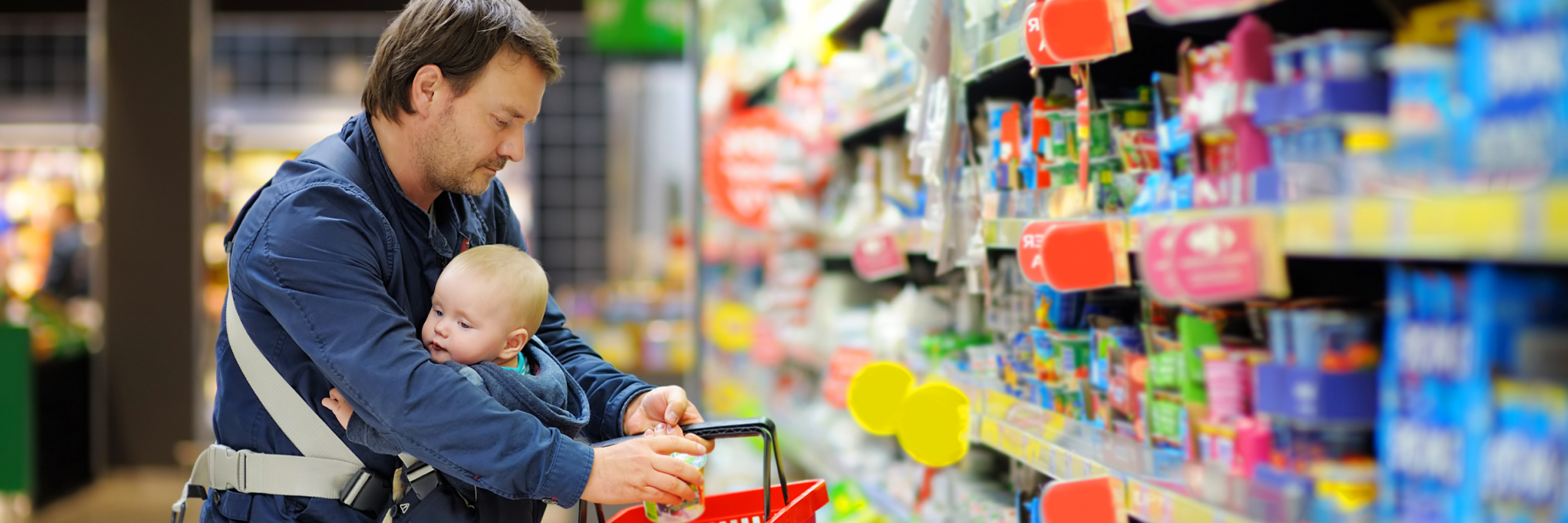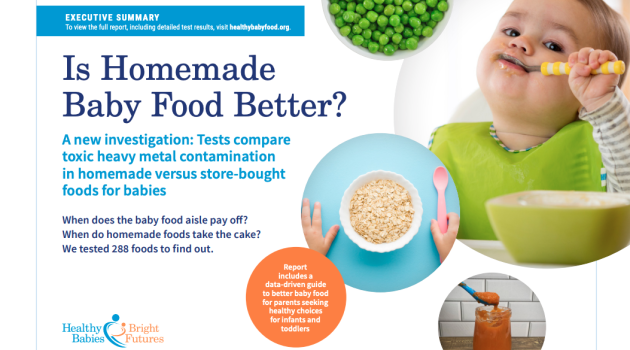
Report: Is Homemade Baby Food Better?

Healthy Babies Bright Futures’ new study tested if homemade baby food is better than store-bought.
The troubling answer? Both were contaminated: 94% of both baby foods and homemade and “family” brands tested were contaminated with one or more of four toxic heavy metals. Heavy metal levels varied widely by food type, not by who made the food.
Report: Is Homemade Baby Food Better?
Executive Summary
Six Tips to Reduce Babies’ Heavy Metals Exposures

Findings & Resources
Healthy Babies Bright Futures’ new study sought to find if homemade purees and foods purchased outside the baby food aisle have lower heavy metal levels than pre-made, store-bought baby food. To find the answer, HBBF tested 288 foods and examined 7,000+ additional food testing data from published studies.
We found no evidence to suggest that homemade baby food has lower heavy metal levels than store-bought brands. Heavy metal levels varied widely by food type, not by who made the food.
Our top findings were:
- 94% of all food samples we tested contained detectable amounts of toxic heavy metals: 94% of store-bought baby food, and 94% of homemade purees and family brand foods.
- Rice cakes and crisped rice cereal are heavily contaminated with arsenic. They contain higher levels of arsenic than any other foods tested. Both stand out as foods to avoid for children and adults alike.
- The 10 most heavily contaminated foods consumed by babies (beginning with the highest) are: rice cakes, crisped rice cereal, rice-based puffs, brown rice, teething biscuits and rice-based rusks, white rice, raisins, teething crackers (non-rice), granola bar with raisins, and oat-ring cereal.
- The 10 least contaminated foods consumed by babies, beginning with the lowest, are: banana, grits, baby food brand meats, butternut squash, lamb, apple, pork, eggs, oranges, and watermelon.
This is a complex problem and will require a multi-pronged solution for both our kitchens and our country.
The Kitchen Solution: Until foods with reliably low heavy metal levels are widely available, parents can choose and prepare foods in ways that significantly reduce babies’ exposures. The most important step: introduce and serve a variety of healthy foods, whether baby food brands or homemade foods. Serving the same food every day for a long time can accidentally concentrate one or more contaminants in a child’s diet. A varied diet avoids this and ensures a healthy mix of nutrients too. See our short parent’s guide for the full food list.
The Country Solution: FDA should establish and enforce protective limits for heavy metals in all foods consumed by babies and young children. Heavy metal contamination spans all the food aisles of the grocery store; FDA’s safety standards must as well. Standards extending beyond the baby food aisle would also encompass foods eaten during pregnancy , a crucial time for lowering toxic metal exposures.
More Information
Our Findings
HBBF tested 288 foods - including popular baby foods like sweet potatoes, carrots, cereal, and bananas - and examined 7000+ additional food tests from other published studies. We found no evidence to suggest that homemade purees and family brands are generally safer, with lower metal levels, than store-bought baby food.
Our study includes a new parent’s guide of popular baby foods to serve, limit, and avoid, based on our tests.
- Four popular foods consumed by babies are so heavily contaminated by heavy metals that we recommend avoiding them altogether.
- Fourteen foods have little contamination and can be served freely.
- Twenty-two foods have moderate to relatively high amounts of heavy metals, to be eaten rarely or in rotation with other foods. For some of these foods, preparation matters — peeling and cooking can lower the heavy metal content.
Research continues to confirm risks for babies from these exposures to heavy metals, including lifelong deficits in intelligence. Despite the risks, with few exceptions there are no specific limits for toxic heavy metals in baby food.
FDA’s multi-year timeline to limit lead, arsenic and other heavy metals in baby food has significant repercussions for infants. Nearly 10,000 babies in the U.S. begin eating solid food every day. Each day that passes has an impact, as children ingest metals that harm neurological development.
The solution is a two-pronged “Kitchen and Country” approach. Until the FDA takes protective action on this issue, parents should choose and prepare foods in ways that significantly reduce babies’ exposures.
And the FDA should establish and enforce protective limits for heavy metals in all foods consumed by babies and young children — not just baby food brands but also fresh and family-style foods babies eat. Heavy metals contamination spans all the food aisles of the grocery store.
HBBF tested 288 foods bought at stores and farmers markets across the United States – including grains, fruits, vegetables, snacks, and family items such as cereals and rice cakes – for lead, arsenic, mercury and cadmium.
Ingredients in many baby foods, including some organic fare, are contaminated with heavy metals like arsenic, lead and cadmium at levels that are far higher than those allowed in products like bottled water, congressional investigators said.
“Even taking one simple step every day can reduce the harm,” Jane Houlihan says. For example, parents can swap fresh or frozen fruit for canned, serve infant oatmeal instead of infant rice cereal, and peel sweet potatoes before cooking them.
The Congressional sub-committee launched an investigation after learning of high levels of arsenic thanks to a in-depth study done by Healthy Babies Bright Futures.
In 2019, a large study from Healthy Babies Bright Futures garnered headlines. The study tested nearly 170 products and found heavy metals and other contaminants present in 95 percent of their samples.

This report’s findings of heavy metals in many of the foods that families routinely feed their young children only adds to the stress families face. The best advice is to offer your child a variety of foods, every day. [It] will reduce the chance of your child consuming a higher concentration of heavy metals from any one food source.
—Moira Szilagyi, MD, PhD, FAAP, president of the American Academy of Pediatrics
Additional Resources
Sign a Letter to the FDA Commissioner
Together, we can tell the FDA that it's time to make the health and safety of the next generation a priority.










